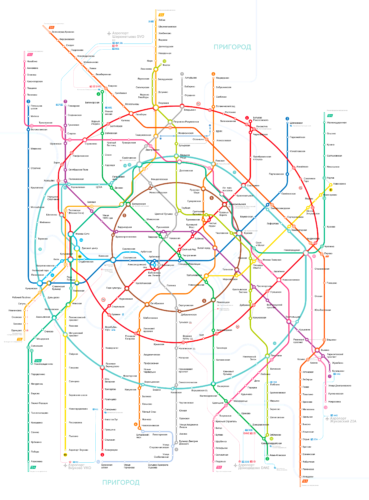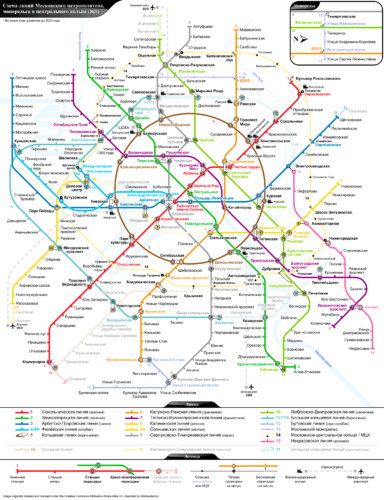Moscow metro, officially known as “Московский метрополитен”, is an extensive underground transportation system that serves the city of Moscow, Russia.
Inaugurated on 15 May 1935, It is one of the oldest and most used metro systems in the world. The metro has 14 lines and 279 stations, covering a total length of 438 kilometres (272 miles), making it a vital component for daily mobility in the Russian capital.
Here's the Moscow metro map, in two different versions:


Moscow metro timetable
The Moscow Metro operates every day from 5:30 from morning to 1:00 am.
Moscow metro fares
This is an updated summary for the year 2024 of Moscow metro fares, expressed in Russian rubles (RUB) and its equivalent in US dollars (USD), assuming an approximate exchange rate of 1 USD = 80 RUB:
Basic rates
- A simple trip: 50 RUB (~0.63 USD).
- 2 trips: 100 RUB (~1.25 USD).
- 20 trips (valid for 90 days): 880 RUB (~11 USD).
- 40 trips (valid for 90 days): 1760 RUB (~22 USD).
- 60 trips (valid for 45 days): 2730 RUB (~34.13 USD).
Time passes
- 1 day (unlimited trips): 230 RUB (~2.88 USD).
- 3 days (unlimited trips): 438 RUB (~5.48 USD).
- 30 days (unlimited trips): 2170 RUB (~27.13 USD).
- 90 days (unlimited trips): 5450 RUB (~68.13 USD).
- 365 days (unlimited trips): 19500 RUB (~243.75 USD).
Rates in extended areas
- 1 travel in area “Suburban” con Troika: 71 RUB (~0.89 USD).
- 1 travel in area “Central” con Troika: 61 RUB (~0.76 USD).
- Subscriptions for the area “Suburban”:
- 30 days: 3240 RUB (~40.50 USD).
- 90 days: 8370 RUB (~104.63 USD).
- 365 days: 24450 RUB (~305.63 USD).
Additional payment methods
- Payment with contactless bank card in the central area: 61 RUB per trip (~0.76 USD)
- Payment with contactless bank card in the suburban area: 78 RUB per trip (~0.98 USD)
- Facepay (biometric payment): 50 RUB in the central area (~0.63 USD), 65 RUB in the suburban area (~0.81 USD)
All these prices are applicable to the use of the card Troika, a rechargeable smart card used to pay for travel. It is important to validate the card when entering and leaving the transportation system to avoid additional charges.
Official Web site
For more information, visit the official site of the Moscow metro.
History of the subway

Moscow metro, one of the most iconic underground transportation networks in the world, was inaugurated on 15 May 1935. Since its opening, The subway has been an emblem of Soviet engineering and a space adorned with art and architecture that reflects the culture of the time.. Initially, The network began with a line running from Sokolniki station to Park Kultury, with a branch to Smolenskaya, covering a distance of 11.2 km and connecting 13 stations.
Over the years, the subway has grown exponentially. This system has evolved with the city, reflecting political and cultural changes, such as the transition from names associated with Soviet figures to a more neutral approach following the collapse of the Soviet Union.
History of the Moscow metro map
The history of the Moscow metro map is as rich and varied as that of the metro network itself. Over the decades, The map design has evolved considerably, reflecting changes in the network and passenger needs.
One of the first and most influential maps was created in 1902 by engineers P. I. Balinski y E. K. Knorre. Although his initial proposal for a metro in Moscow was rejected, His vision helped lay the foundation for future developments.
During the Soviet era, the subway map adopted a more functional and stylized design, similar to iconic london tube map, designed by Harry Beck. This style sought to simplify the representation of lines and stations to facilitate understanding and use by users..
Over the years, various architects and artists have contributed to the aesthetics of the Moscow metro map. During the period of 1935 a 1950, architects like I. A. Fomin y A. V. Shchusev, along with artists like A. A. Deyneka and sculptors like N. V. Tomsky, They participated not only in the design of the stations, but they also influenced the graphic design associated with the subway, including your maps.
In summary, although specific information on each individual designer of the subway maps over the years is scant., It is clear that many talented professionals have left their mark on the evolution of this important aspect of the Moscow Metro. Each new version of the map has not only sought to improve functionality and aesthetics, but also adapt to the continuous expansion of the metro network.
Additional data
The Moscow metro is not only known for its efficiency and extension, but also for its impressive interior architecture. Some stations are adorned with marbles, mosaics and chandeliers, making the trip a cultural experience in itself. Besides, This metro is one of the deepest in the world, with the station Park Pobedy being one of the deepest with 84 meters underground.
These are the main important or tourist sites in Moscow and how to get there by metro:
- Teatro Bolshoi (Teatralnaya, Zamoskvoretskaya Line) – One of the most famous theaters in the world, known for his grandiose ballet and opera productions.
- Red Square (Okhotny Ryad, Sokolnicheskaya line) – The historic heart of Moscow, Home to the Lenin Mausoleum and surrounded by the Kremlin and the historic GUM shopping center.
- Cathedral of Christ the Savior (Kropotkinskaya, Sokolnicheskaya line) – The tallest Russian Orthodox church in the world, originally built in the 19th century and rebuilt in the years 90.
- Luzhniki Stadium (Sportivnaya, Sokolnicheskaya line) – Russia's main stadium, used for major sporting events, including the Olympic Games 1980 and the FIFA World Cup 2018.
- Tretyakov Gallery (Novokuznetskaya, Zamoskvoretskaya Line) – Museum that houses one of the largest collections of Russian art, from Orthodox icons to modern masterpieces.
- Moscow State University (University, Sokolnicheskaya line) – The oldest and most prestigious university in Russia, notable for its Stalinist-style main building.
- Victory Park and Museum of the Great Patriotic War (Park Pobedy, Arbatsko-Pokrovskaya line) – An extensive park dedicated to the Soviet victory in World War II, with monuments and a museum that tells the history of the conflict.
- Novodevichy Convent (Sportivnaya, Sokolnicheskaya line) – A historic convent dating back to the 16th century, famous for its golden domes and its cemetery where many prominent Russian figures rest.
- Russian White House (Krasnopresnenskaya, Circular Line) – Government building serving as the headquarters of the Government of the Russian Federation, similar in function to the United States White House.
- Seven Sisters (Various stations, including Komsomolskaya on the Circular Line and Barrikadnaya on the Tagansko-Krasnopresnenskaya Line) – Group of skyscrapers in Stalinist Gothic style built in the 1970s. 1950 under the direction of Stalin to demonstrate the power and scope of Soviet architectural art.